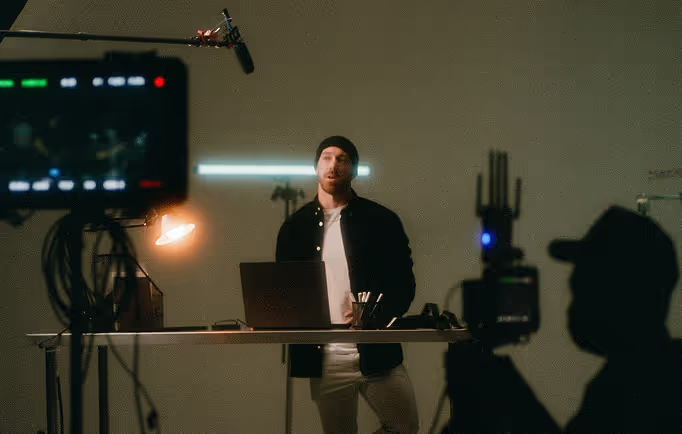These 5 Classic Writing Tips Can Make Or Break Your Brand Videos

Writing is one of those skills that seeps into almost every other creative pursuit—songs need lyrics, art needs critical interpretation, and videos need scripts. It’s no surprise then that good copywriting is powerful enough to salvage a mediocre project, or destroy an otherwise reasonable one.
Over the centuries some well-known ‘best practice’ tips have emerged to guide new and experienced writers in creating quality work. Though the tips were originally developed with creative writing in mind, today we’re taking a look at how they also apply to writing scripts for brand videos, corporate animation, and explainers.
1) show, don’t tell
There’s nothing viewers hate more than a preachy video. It can be outrageous, boring, even outright offensive, and someone somewhere will find appeal in it. But when a message is sermonised, it has an uncanny way of losing its power.
We humans (sorry to exclude the few hyper-intelligent dolphins reading this article) are social animals, and interestingly enough we’re born with a subconscious urge to copy each other. Gestures, speech patterns, ideals of acceptable behaviour: we’re wired to mimic it all to fit in. That’s why the concept ‘Show, don’t tell’ is so effective in arts and media. Somebody tells us how to behave, we process those words externally. Somebody demonstrates the behaviour and its effects, we process the experience more viscerally and have an easier time recalling what the outcomes of that behaviour are.
‘Show, don’t tell’ applies to both the writing and visuals of a video, though infographics can get away with using basic visuals to demonstrate a process or idea directly as a memory association technique.
2) start in the middle
Ever had someone tell you about a ‘funny’ thing that happened to them at the bar the other night, but instead of getting right to the point they go back to the very start of the day and tell you what they had for breakfast—porridge with brown sugar—because you know, I’ve been trying to focus more on my slow-release carbs, but did you know that brown sugar is no healthier for you than white sugar? True fact, I only just found this out, I swear, when I was googling about the benefits of honey versus sugar and—no wait, I was googling about bees first, how many bees could you take on in a street figh—
It’s roughly at this point you’re ready to start cutting off your own ears because, holy cow, this story was supposed to be about the bar and now you’re getting this guy’s entire life story. Starting in the middle saves us from telling boring anecdotes and it saves us from making boring videos. People don’t need (or want) to know about the history of your brand before they know what problems your brand can solve for them. They don’t need to know how the product works before they know why it’s needed in the first place.
adverbs are the enemy
This concept continues on from the ‘show don’t tell’ guideline. There’s nothing inherently wrong with using the occasional adverb—I’m more guilty than most—but reliant use clogs up the flow of words and signals a deeper problem of ‘telling’ within the writing.
When we read “He ate the pizza hungrily,” what does ‘hungrily’ reveal about the character? Nothing at all, other than that the character is hungry, which we can generally assume from the fact that he’s eating. We could read “He ate the pizza,” and get the same effect, without the writer treating us like dopes who’ve never eaten a pizza before.
More to the point, when we rely on adverbs we miss opportunities to show, through actions, what the character is really doing. “He ate the pizza. Well, ‘ate’ is the polite word. Cheese was inhaled, sauce was applied like moisturiser around the cheeks, and in the frenzy, a stray pepperoni somehow ended up lodged in his left nostril.” In writing we’re painting a mental picture—and in the video world, we create a visual one. Don’t miss the opportunity to support your message visually. (Yes, ‘visually’ is an adverb.)
read more, observe more
If you want to be good at almost anything, you must understand your field. If you want to be a great writer, read more and understand what people consider great writing of the past and present. If you want to be a great scriptwriter, watch your chosen media first as an audience member, then as an analyst, observing the presence and flow of the screenwriting. Observe more of real life, real human behaviour, taking note of how people really talk and act.
The positive effects of observing more are two-fold for branded video writing: first, you develop a stronger sense of story structure and a more innate understanding of how humans ‘read’ on-screen. Second, observing more media gives you a clearer idea of what’s already been done to death. It’s an easy trap to fall into – after all, cliches seem like great ideas before they become cliches.
just do it
Anyone who’s actually done it will tell you writing is hard. Anyone who hasn’t will tell you it looks easy. There’s a reason so many authors end up as depressed alcoholics – writing is one of the odd activities which requires a huge amount of mental focus, but seems almost effortless to those around us. All sweat, no applause.
But it’s also one of the few activities that requires no money, no special equipment and no physical prowess—just time. Time to practice, time to get better, time to research, and time to allow yourself to write poorly. This last one’s the hardest hurdle for people who think a blank page must be better than a bad page. The fact of the matter is you can’t edit a blank page, and you can’t write something good if you don’t write anything at all.
Just start. Write an outline for your brand video. Write down what problem your brand is trying to solve. Write a call to action. Don’t worry about fancy wording yet—just write what you know needs to go in the video. Then form those ideas into images and sentences. Read those sentences aloud to someone else—does what you’re saying sound natural? Is your message clear? Edit those sentences until it is. You won’t always nab the perfect sentence, but you can always make your message clear.
Start a






